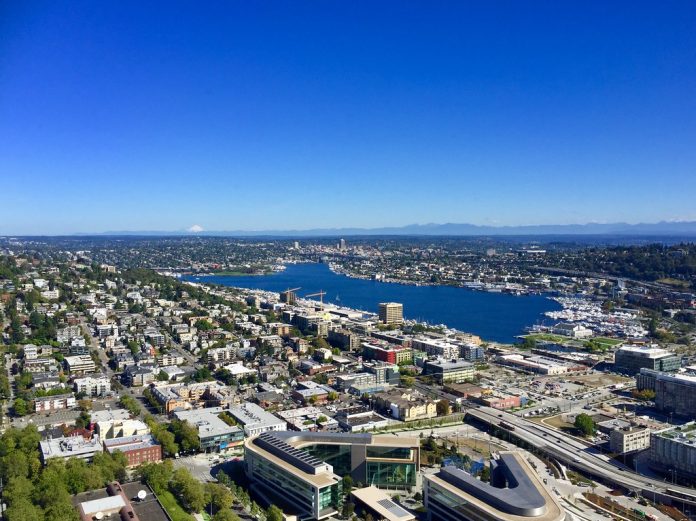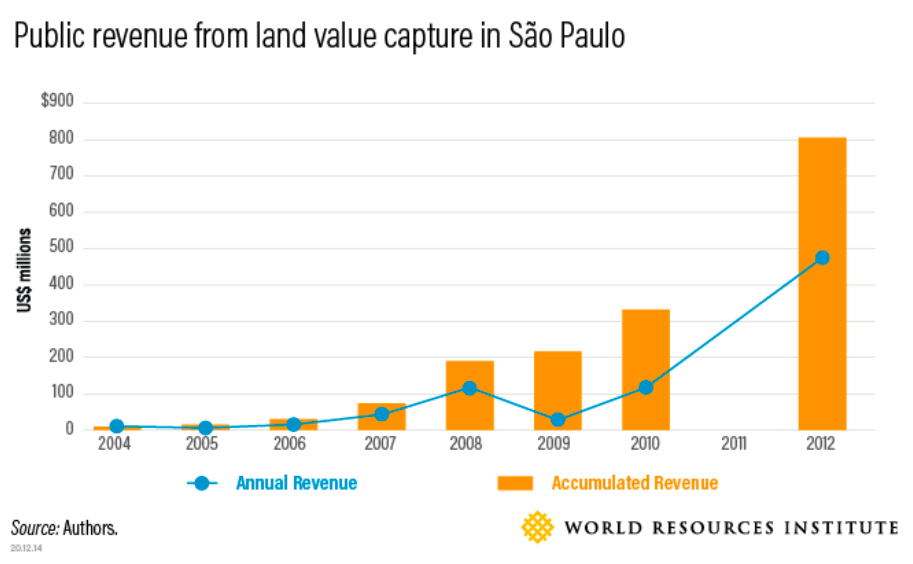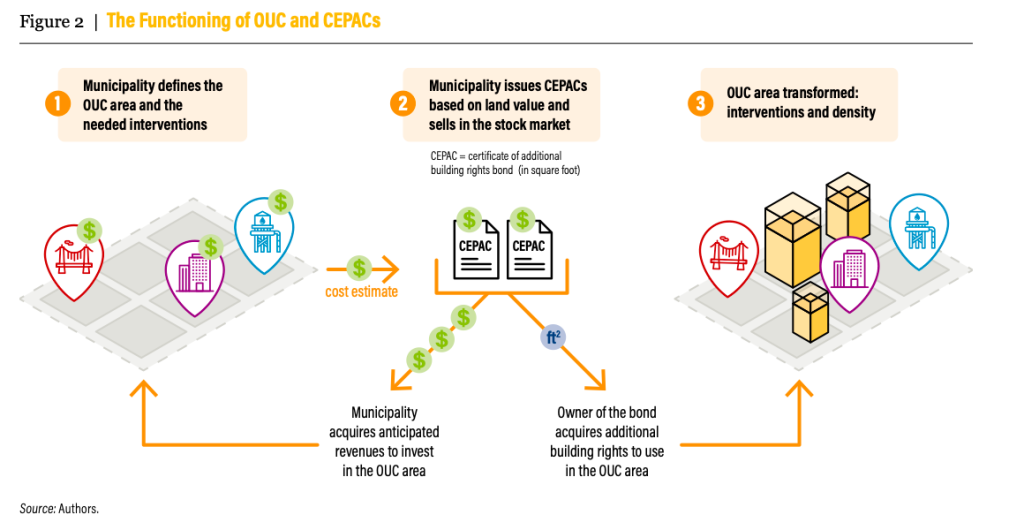
In an era of tight city budgets, legal limits on taxing authority, and expensive problems, it is time for Seattle to get creative. We can’t tackle issues like homelessness, crumbling infrastructure, and overreliance on cars if we stick with our current leadership’s go-small planning.
We should start by selling air. We’ve got lots of it, and it sells for a pretty penny in other places. The sale of these air rights, known in wonk circles as a kind of “land value capture,” can turn a property owner’s financial windfall into an investment in the public good. Around the world, a growing number of cities are selling development rights — or seriously exploring doing so — for funding important public investments like safe streets for walking and biking, parks, and, most importantly for Seattle, affordable housing.
São Paulo shows that the space over the city of Seattle can work like a giant land bank, worth hundreds of billions of dollars. This is because we the people control development rights. Most of the residential land in Seattle comes with very little right to build, limiting structures to a floor-to-area ratio (“FAR”) of 0.5. This means you can only put up 2,500 square feet of housing on a 5,000 square foot piece of property. The rest of the potential use for that sliver of land? Held back, by the people, for the people, at least in theory.

But what does holding it back give us, the people, anyway? Some added sunlight, which is nice, and perhaps a little extra space for some urban trees, though plenty of well-developed cities have more of those than Seattle. The downside to hoarding this air is enormous: the restrictions are a large part of why we don’t build enough housing, which gives us astronomical housing prices, incomplete neighborhoods, and a slavish dependence on cars and suburban sprawl. It cooks the planet and locks our Black and brown and working class neighbors out of the neighborhoods that offer children the best chance at a prosperous life. To top it off, our tax code ensures that we have way too little money to pay for serious capital investments in parks, housing, and transit.
So we should sell some of these air rights in neighborhoods with solid transit, schools, and parks, the kinds of places that maximize upward mobility for families and where displacement risks are lower. Since auctions maximize the total price paid by the buyers, we can take a page from the federal government’s playbook with radio spectrum and auction them off. We should keep the money raised in the neighborhood where the air rights are sold, building affordable housing and transit, sidewalks, bike lanes, parks and preschools.
Paulo Sandroni, an economist, published a study with The Lincoln Land Institute in Cambridge Massachusetts analyzing just such a scheme in São Paulo, called CEPACs. These are “Certificates of Additional Development Potential.” The auctions generated almost four times the revenue compared to the previous approach, which was similar to Seattle’s inclusionary zoning program. Julie Kim, Director of Stanford’s Global Project Center, claims the program covered 15% of the city’s capital costs while using less than 0.1% of its developable land.
Selling development rights works better than inclusionary zoning for several reasons:
- Upzones are big giveaways to landowners and developers. Inclusionary zoning just claws a small portion of that back.
- Auctioning air rights is better politics. This is because humans hate losing things — a phenomenon called loss aversion. If we hand out windfalls like upzones, and then charge people to try to claw some of it back via inclusionary zoning like we do today, people get motivated and fight for lower fees. Landowners are much less likely to oppose the city raising revenue if the money was never theirs in the first place.
- Bureaucrats are bad at pricing, which is required by inclusionary zoning. Prices are often too high, which means no developments get built. Or they are too low, which means the public gets ripped off. Often it is both. Prices should fluctuate with supply and demand, so we maximize building and revenue.
- Our inclusionary zoning prices don’t vest until much later in the development process, which substantially raises developer risks. That means fewer units and less money raised for the city. Auctioning off rights that vest at the time of purchase can fix this.
- Investors who aren’t developers have an incentive to buy development rights and sell them later. This makes tons of new money available to the city that would otherwise have had to come directly from the more limited funds available from taxpayers and landowners.
- Auctions bring in revenue right away. This is better than inclusionary zoning, which depends on developers to finish a project. That means lots more money for cities, up front. This is especially important when infrastructure inflation outpaces land price increases. Getting the money faster means a whole lot more affordable housing, parks and transit.
- The certificates are contracts. Because of constitutional constraints, that means future neighborhood opposition cannot renege on the development rights.
- In the São Paulo model, the money raised had to go back into the neighborhoods where the rights were purchased, which were often slums at risk of displacement. This is a great way to benefit longtime residents in neighborhoods that are gentrifying, because it can pay for the affordable housing required to fully avoid displacement. Too often, inclusionary zoning money ends up going to other neighborhoods.
How much would such a certificate sell for in Seattle? This is a difficult question. CePecs took a bit to get going, as people figured out whether the market for them was really going to materialize. Over time, they increased from $35 per square foot of development capacity in the first decade, to closer to $185 per square foot in 2019. The average price of a home, per square foot in Brazil, is cheaper than in Seattle, so perhaps they would sell for more here after the market matures.

Of course, if the program is designed poorly, it won’t work. King County has a transfer of development rights program that has difficulty generating even $20 per square foot, in part because it competes with other incentives like inclusionary zoning. But this means that the other incentives we are offering are probably far too cheap and are thus a huge wealth transfer from the public to our landed gentry.
New York City’s carefully crafted transfer of development rights program has matured and fared much better. A 2015 report by the New York City Department of City Planning said that transactions trended toward about $225 per square foot. According to Mazars, an international tax advisory firm, prices average around 50% the value of the developable land price. From a random sample of Seattle properties, this implies a residential price of $24 in Columbia City, $41 in the University District and Roosevelt, and $53 in South Lake Union and $54 per commercial foot in the downtown core.
This would raise a lot of money. In the last six years, we’ve added 8,661 housing units in Seattle per year, at an average of about 635 square feet per apartment. At an 80% efficiency ratio that works out to 6.9 million square feet per year. We’ve also added about 3.7 million square feet of commercial space in the same time period. Had all this come through the purchase of development rights, it would have raised $451 million per year. Even if only half the development came through floor area expansions, that’s $1.35 billion over the six years.
That’s enough to fund 3,857 permanent supportive homes, which could house all of King County’s count of 3,355 chronically homeless people and then some. Or it could have been put to use housing more than 20,000 lower-income families. Or it could have blanketed Seattle with 150 miles of protected bike lanes and knocked out nearly a quarter of our 11,000 missing blocks of sidewalk. We need that money.
This isn’t development pandemonium. It’s just an efficient and aggressive way to increase development and benefit the community through land value capture, which is what inclusionary zoning attempts to do. As in São Paulo, pricing would be sold by neighborhood. Each part of the city would need maximums in place, to avoid wrecking neighborhoods with buildings that far exceed scale. The maximum FAR and height will look different for different places. Perhaps Belltown could handle dramatic increases of 20 floors. Single-family neighborhoods certainly could not, though they might benefit from four floors and a corner store. Properties within 10 or 15 minutes of Link light rail will have different limits than than those with little transit. But rather than just upzone and give away all the value to the owners, we require those who want to develop to pay for the right, just as they do when they buy land.
We’ve been in a homelessness “emergency” for more than half a decade. We are facing a climate crisis. Fixing these problems is expensive, and we have limited taxing authority. We also need to build housing faster. While I don’t think we should dismantle the political coalition behind Housing Affordability Livability Agenda (HALA), which was a brilliant political and policy step forward, we do need to look at more effective ways of raising funds. Auctioning off development rights can help us take a big step toward solving all these problems.

Ron Davis (Guest Contributor)
Ron Davis is an entrepreneur, policy wonk, political consultant, and past candidate for Seattle City Council. He is focused on making his community a place where anyone can start a career, raise a family, and age in place without breaking the bank. He has a JD from Harvard Law School and lives in Northeast Seattle with his wife — a family physician — and their two boys.
